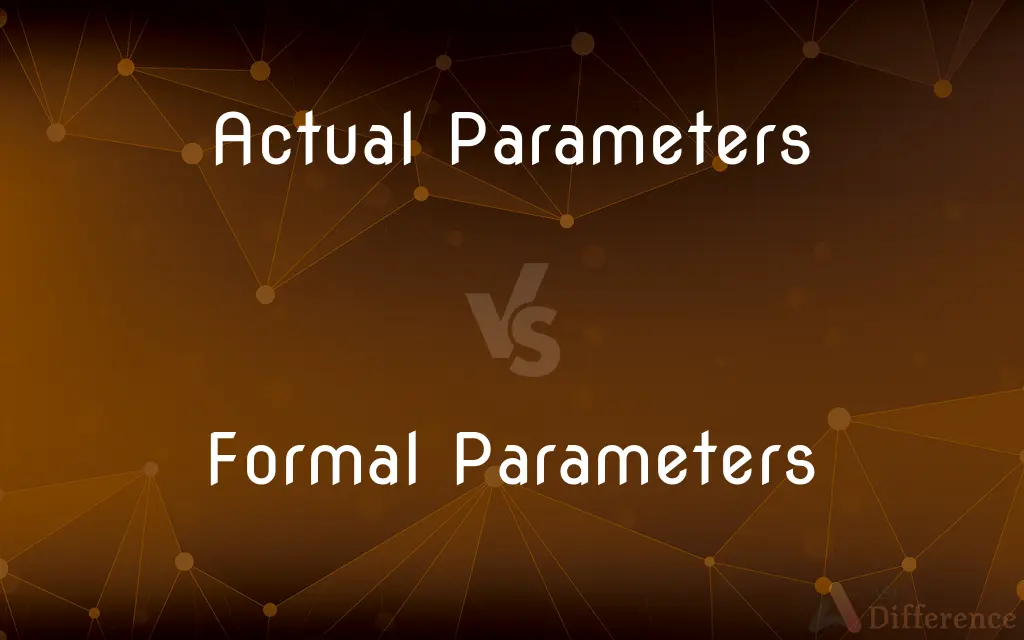Actual Parameters vs. Formal Parameters — What's the Difference?
By Tayyaba Rehman — Published on January 1, 2024
Actual Parameters are values or expressions passed into a function during its call. Formal Parameters are variables used in a function's definition to receive actual parameters.

Difference Between Actual Parameters and Formal Parameters
Table of Contents
ADVERTISEMENT
Key Differences
Actual parameters refer to the values or expressions passed into a function when it is called. They provide the actual data that the function will work with during its execution. For example, if you have a function that calculates the sum of two numbers, the numbers you pass to this function when calling it are the actual parameters.
On the other hand, formal parameters are variables used in the function's definition to receive the actual parameters. These variables act as placeholders for the values that will be passed into the function. In many programming languages, you define formal parameters within the parentheses of the function's declaration.
A key distinction is that actual parameters are specific values or expressions, while formal parameters are variable names used within the function's scope. When the function is called, the values of the actual parameters are assigned to the formal parameters, allowing the function to work with them locally.
This separation of actual and formal parameters is fundamental in function-based programming. It allows functions to be reusable with different data inputs, promoting modular and efficient code. Understanding this difference is crucial for designing and using functions effectively in programming.
Comparison Chart
Definition
Values passed into a function during its call
Variables used in a function's definition to receive actual parameters
ADVERTISEMENT
Role
Provide actual data for a function's execution
Act as placeholders for actual parameter values
Example
Passing 5 and 7 as actual parameters: add(5, 7)
Defining parameters: function add(x, y)
Assignment
Actual values assigned to formal parameters
Formal parameters are local variables within the function
Compare with Definitions
Actual Parameters
Actual parameters can be values or expressions.
ComputeArea(length * width) passes an expression as an actual parameter.
Formal Parameters
Formal parameters are variables in a function's definition.
Function calculateSum(x, y) defines formal parameters x and y.
Actual Parameters
They are assigned to formal parameters within the function.
In add(x, y), x and y receive the values of actual parameters when called.
Formal Parameters
They act as placeholders for actual parameter values.
In printMessage(message), message is a formal parameter.
Actual Parameters
Actual parameters are values passed into a function during its call.
In calculateSum(3, 6), 3 and 6 are actual parameters.
Formal Parameters
Formal parameters define the function's input structure.
FindMax(a, b, c) defines how the function accepts input for comparison.
Actual Parameters
They provide specific data for a function's execution.
The function printMessage(Hello) receives Hello as an actual parameter.
Formal Parameters
They facilitate the generalization of functions.
CalculateAverage(values) can be used with different sets of values.
Actual Parameters
Actual parameters are used to customize a function's behavior.
FindMax(14, 25, 9) customizes the search for the maximum among these values.
Formal Parameters
Formal parameters have local scope within the function.
ComputeArea(length, width) can only access length and width locally.
Common Curiosities
What are formal parameters in programming?
Formal parameters are variables used in a function's definition to receive actual parameters.
Why are formal parameters important in programming?
Formal parameters allow functions to be generalized and reused with different data inputs, promoting modular and efficient code.
What is the role of actual parameters in a function call?
They provide specific data for the function's execution, customizing its behavior.
What are actual parameters in programming?
Actual parameters are values or expressions passed into a function during its call.
What happens when a function is called with actual parameters?
The values of the actual parameters are assigned to the formal parameters within the function, allowing it to work with those values locally.
How do formal parameters differ from actual parameters?
Formal parameters act as placeholders, while actual parameters provide specific data. Actual values are assigned to formal parameters within the function.
Do formal parameters have local scope within a function?
Yes, formal parameters are locally scoped variables within the function.
Can actual parameters be values or expressions?
Yes, actual parameters can be either specific values or expressions.
How do formal parameters contribute to code readability and reusability?
Formal parameters define a function's input structure, making it clear how to use the function and enabling its reuse with various inputs.
What is the purpose of using formal parameters in functions?
Formal parameters define the function's input structure and enable the function to work with different data inputs.
Can a function have multiple sets of actual parameters?
Yes, a function can be called with different sets of actual parameters to perform different tasks.
Is there a limit to the number of formal parameters a function can have?
The number of formal parameters a function can have depends on the programming language and its specifications.
Are formal parameters visible outside the function where they are defined?
No, formal parameters are only visible and accessible within the scope of the function where they are defined.
How does using actual and formal parameters improve code maintainability?
Separating actual and formal parameters makes it easier to understand and modify functions, enhancing code maintainability and readability.
In a function declaration, where are formal parameters defined?
Formal parameters are defined within the parentheses of a function's declaration.
Share Your Discovery

Previous Comparison
Prosthetic Group vs. Coenzyme
Next Comparison
AMU vs. GramsAuthor Spotlight
Written by
Tayyaba RehmanTayyaba Rehman is a distinguished writer, currently serving as a primary contributor to askdifference.com. As a researcher in semantics and etymology, Tayyaba's passion for the complexity of languages and their distinctions has found a perfect home on the platform. Tayyaba delves into the intricacies of language, distinguishing between commonly confused words and phrases, thereby providing clarity for readers worldwide.














































